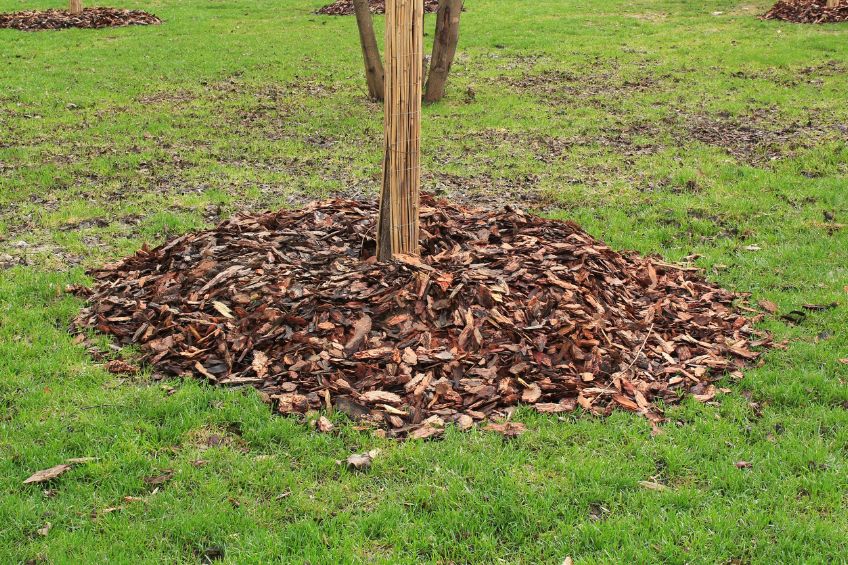Winter can be unrelenting, yet trees don’t need to face it unguarded. With the simple act of mulching, roots stay warm, soil remains moist, and new growth is quietly prepared beneath the surface.
This careful layer becomes both a shield and a promise, guiding trees safely through the cold.
Choose the Right Mulch for Lasting Protection
The choice of mulch sets the tone for the entire season.
Wood chips, straw, shredded bark, and small-cut autumn leaves are examples of organic materials that work well. They insulate soil, release nutrients as they decompose, and encourage healthy soil life.
Local tree surgeons sometimes offer free wood chips, which helps both garden and budget. Likewise, composted garden waste can be repurposed into a protective layer, keeping the process sustainable. The soil is therefore enriched, and nothing goes to waste.
Plastic and rubber mulches, on the other hand, tend to suffocate the soil and can gradually upset its balance, so they’re best avoided.
A thoughtful mix of natural materials, such as wood chips with straw, creates an insulating yet breathable layer that holds moisture while keeping conditions steady. This simple approach is far more reliable for healthy trees.
As frosts draw closer, consider how mulch not only shelters but also supports. A mindful choice in autumn ensures roots stay warm until spring lightens the days again.
Prepare the Ground Before Mulching
A clean base is the key to effective mulching.
Before laying new material, remove matted, diseased, or crusted mulch, weeds, and debris. Left unchecked, these can harbour pests and disease, ready to trouble the trees once temperatures rise.
This clearing also allows new mulch to touch bare soil, improving its insulating qualities. A rake or simple hand tools will do the job, though take care not to compact the soil, especially near the delicate root flare where the trunk meets earth.
Loosening the top layer of soil can also help. It improves water absorption, aids aeration, and gives roots freedom to spread. These small steps create a fertile ground that makes the mulch more effective, working harder for the tree through the long winter.
Such preparation feels modest, yet it lays the groundwork for resilience, setting the tone for the months ahead. As the soil breathes, it quietly readies itself for the shelter about to be placed upon it.
Apply Mulch at the Right Depth
The thickness of mulch makes the difference between protection and harm.
Around 7–10 centimetres is generally ideal—enough to hold warmth, but not so much that roots become starved of air. Too little and the cold seeps in, while too much and moisture lingers, leading to rot.
Spread the mulch in an even circle, leaving a 5–10 centimetre gap around the trunk so the bark remains dry. Aim for a doughnut shape rather than a mound, keeping the surface level or sloping slightly outwards to prevent water from pooling.
This layout ensures rainfall soaks into the soil while air circulates freely, giving roots the conditions they need to stay healthy.
Placed with thought, mulch not only protects roots but also stabilises the ground, reduces erosion, and locks in valuable nutrients. As winter storms approach, that steady layer serves as a quiet shield against their bite.
Create a Ring for Better Results
Rather than scattering mulch haphazardly, shape it into a defined ring around the tree’s base.
Keep it a short distance from the trunk itself, leaving a circle of bare soil so that bark stays dry and free of decay.
This ring works like a buffer, guarding the root zone from frost and keeping competing weeds at bay. It also channels resources where they’re needed most, ensuring the tree drinks deeply from the soil without losing strength to intruders.
For older or taller trees, the mulch circle may extend further, ideally out to the dripline where possible. Think of it as mirroring the canopy above with a protective halo below.
Additionally, this constant ring serves as a buffer against abrupt temperature drops as evenings get darker and frost becomes a frequent visitor.
And while mulch offers much, remember that some challenges go beyond its reach. For serious structural problems or the need for tree felling, professional help is always wise.
Avoid Mistakes That Undo the Good
It’s surprisingly simple to go wrong with mulch.
Piling it directly against the trunk invites moisture and decay, damaging the bark that serves as the tree’s armour. So, always leave a gap so air circulates freely.
Fresh mulch may introduce pests or pathogens if contaminated. Otherwise, arborist wood chips are generally safe. Part-composted mulch is often more stable, feeding the soil steadily without tying up nitrogen.
Choosing the wrong type can also create problems, so local advice is worth seeking. What thrives in one region can struggle in another, and trees respond best to what suits their environment.
Dodging these common errors ensures mulch does its job well, helping trees glide through winter unscathed. And by paying attention now, you’ll avoid the disappointment of seeing damage that could so easily have been prevented.
Keep Watch as the Season Shifts
The story doesn’t end with the laying of mulch. Throughout winter, snow, wind, and rain can scatter or compress it.
A quick check now and again keeps it in working order. If the layer looks thin or patchy, top it up gently, restoring it to its protective depth.
Lightly turning the mulch from time to time also helps, fluffing it so that water and air pass through more freely. This keeps the soil beneath lively rather than stagnant, giving roots the best conditions even in the coldest months.
When spring finally comes and the last frost has lifted, it’s time to pull mulch back from the trunk. This lets soil warm, awakens roots, and reduces the risk of lingering dampness.
There’s no need to throw away old mulch. Worked into a compost heap, it transforms into nourishment for the season ahead, continuing the cycle.
Such continuous care completes the cycle, making winter’s preparation the initial step towards spring’s rejuvenation.
And with each period, trees become more robust, their growth steadier, and their presence in the landscape more enduring. Even a little regular attention makes a noticeable difference when the seasons turn, especially in the UK’s damp, changeable climate.
Conclusion
Mulching before winter is a quiet act of foresight that spares trees from unnecessary strain.
Each layer is both a blanket and nourishment, offering comfort through the cold and strength for the season to come.
With steady attention now, trees awaken in spring refreshed, thriving, and ready to flourish.



